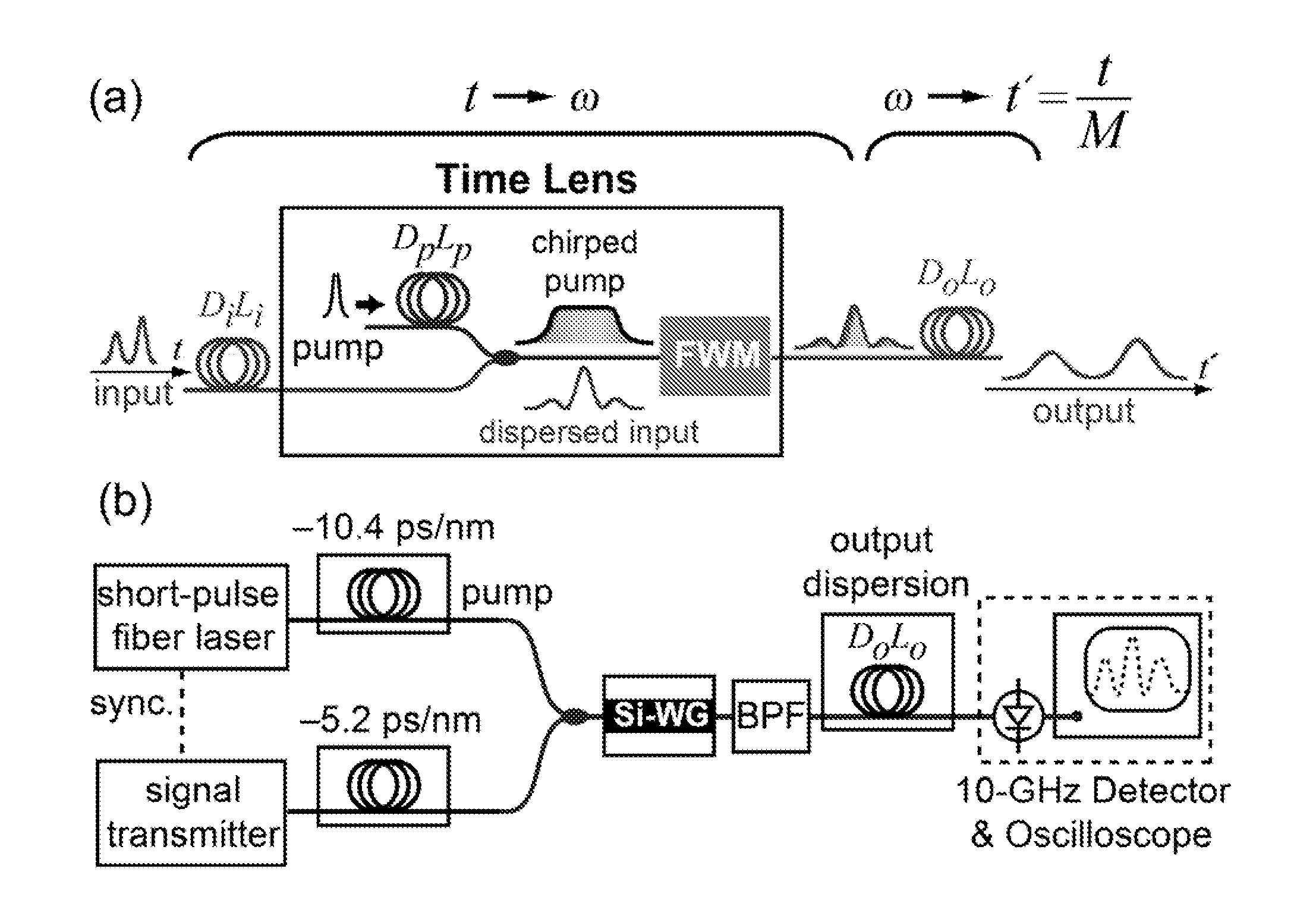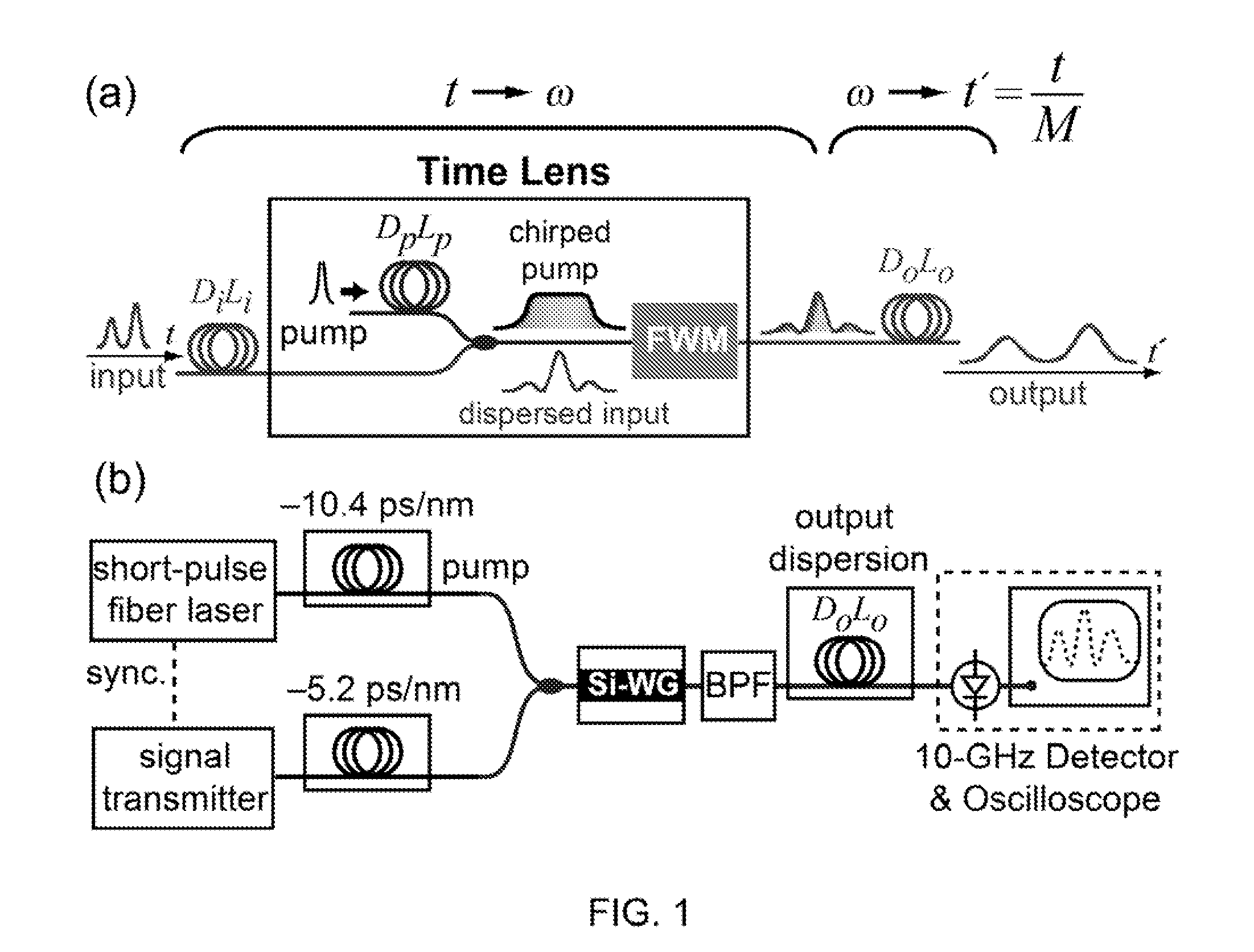High-speed optical sampling by temporal stretching using four-wave mixing
a temporal stretching and optical sampling technology, applied in electromagnetic transmission, electrical equipment, instruments, etc., can solve the problems of limited sampling rate of 60 gs/s, inability to sample short optical packets, and inability to operate single-sho
- Summary
- Abstract
- Description
- Claims
- Application Information
AI Technical Summary
Problems solved by technology
Method used
Image
Examples
example 1
6.1 Example 1
Silicon-Chip-Based Ultrafast Optical Oscilloscope
Introduction
[0200]This example demonstrates the general principles configuration, design and function of a silicon-chip-based ultrafast optical oscilloscope. These general principles can be applied to the temporal stretching systems and methods, as disclosed hereinabove and in Example 3 (for high-speed optical sampling using a silicon-chip temporal magnifier).
[0201]With the realization of faster telecommunication data rates and expanding interest in ultrafast chemical and physical phenomena, simple measurements of optical waveforms with sub-picosecond resolution is increasingly important (C. Dorrer, High-speed measurements for optical telecommunication systems, IEEE J. Sel. Top. Quantum Electron. 12, 843-858 (2006)). State-of-the-art oscilloscopes with high-speed photodetectors provide single-shot waveform measurement with 30-ps resolution. While multiple-shot sampling techniques can achieve few-picosecond resolution, sin...
example 2
6.2 Example 2
Optical Time Lens Based on Four-Wave Mixing (FWM) on a Silicon Chip
[0232]This example demonstrates the general principles of configuration, design and function of an optical time lens based on four-wave mixing (FWM) on a silicon chip. These general principles can be applied to the methods and system for high-speed optical sampling using a silicon-chip temporal magnifier, as disclosed hereinabove and in Example 3.
[0233]The example demonstrates a technique to realize an optical time lens for ultrafast temporal processing that is based on four-wave mixing in a silicon nanowaveguide. The demonstrated time lens produces more than 100π of phase shift, which is not readily achievable using electro-optic phase modulators. Using this method 20× magnification of a signal consisting of two 3 ps pulses is demonstrated, which allows for temporal measurements using a detector with a 20 GHz bandwidth. The technique offers the capability of ultrafast temporal characterization and proce...
example 3
6.3 Example 3
High-Speed Optical Sampling Using a Silicon-Chip Temporal Magnifier
[0242]This example demonstrates the utility of a FWM-based time lens for temporal stretching of high-speed signals by factors as large as 520, such that the sampling can be performed using low-speed electronic devices. It also demonstrates single-shot sampling at sampling rates exceeding 1 TS / s and performance monitoring at 80 Gb / s as two important applications of this device. The read-out rates achieved using this scheme approach nanosecond time scales, which allows for characterization of rapidly-varying signals. The implementation described in this example is a fully-guided system that utilizes a silicon nanowaveguide, based on the CMOS-compatible silicon-on-insulator technology, and commercially-available single-mode optical fibers. In addition to their robust and electronics-compatible platform with a standard fabrication process, silicon waveguide devices allow power-efficient (R. L. Espinola, J. I...
PUM
 Login to View More
Login to View More Abstract
Description
Claims
Application Information
 Login to View More
Login to View More - R&D
- Intellectual Property
- Life Sciences
- Materials
- Tech Scout
- Unparalleled Data Quality
- Higher Quality Content
- 60% Fewer Hallucinations
Browse by: Latest US Patents, China's latest patents, Technical Efficacy Thesaurus, Application Domain, Technology Topic, Popular Technical Reports.
© 2025 PatSnap. All rights reserved.Legal|Privacy policy|Modern Slavery Act Transparency Statement|Sitemap|About US| Contact US: help@patsnap.com



